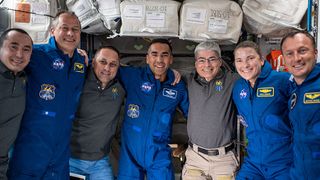Space station astronauts resume normal operations after Russian anti-satellite missile test

Astronauts at the International Space Station have returned to normal operations after a couple of adrenalin-filled days following a Russian anti-satellite missile test that threw an out-of-control cloud of space debris into the station's orbit.
Hatches leading to modules farther away from the space station's core were opened Wednesday (Nov. 17) at about 1:20 a.m (EST), NASA said in a statement, giving astronauts once again a little bit more life space. During the shutdown, which started early Monday (Nov. 15), the Japanese Kibo module, the European Columbus module, the Bigelow inflatable habitat as well as NASA's Permanent Multipurpose Module and the Quest airlock were all sealed off.
NASA said that during the first three days after the destructive incident, the space station didn't have to perform any space junk-dodging maneuvers. The highest risk of collision has now passed, the agency added.
Related: Space debris from Russian anti-satellite missile test spotted in telescope images and video
As the cloud of thousands of pieces of debris from the shot-down Cosmos 1408 satellite spread around in low Earth orbit (the heavily used nearest few hundred miles of space), the astronauts and cosmonauts were forced to repeatedly seek shelter in their transport capsules. If a piece of debris were to hit the space station in a way that couldn't be fixed by simply isolating the affected segment, the space travelers would have to return to Earth immediately, NASA said in the statement.
The space agency admitted that the Russian act, which generated at least 1,500 trackable fragments and possibly tens of thousands of smaller untrackable pieces, increased the overall space debris risk that the space station is exposed to. Experts say that this increased risk will persist for years.
The U.S. Space Command and NASA continue cataloging the fragments and analyzing their trajectories in order to gain clarity on the future risks. It's not just the space station that is in danger but also the thousands of satellites that fly in this region of space, that includes SpaceX's internet-beaming constellation Starlink or the Planet fleet of Earth-observing spacecraft.
Get the Space.com Newsletter
Breaking space news, the latest updates on rocket launches, skywatching events and more!
NASA said in the statement it will continue performing visual inspections to make sure the station is safe for the crew and act upon any possible space debris alert it might receive.
During the emergency, the seven crewmembers on board the station (NASA astronauts Thomas Marshburn, Raja Chari, Mark Vande Hei and Kayla Barron, European Space Agency's Matthias Maurer and Russian cosmonauts Pyotr Dubrov and Anton Shkaplerov) had to abandon their work schedules.
For Marshburn, Barron, Chari and Maurer — who only arrived at the space station three days earlier — the Russian ASAT test delivered an unexpectedly dramatic welcome. The Russian military, which claims the test didn't create any hazard in orbit, shot Cosmos 1408 into pieces in spite of the fact that two of their nationals are currently on the space station. About a month earlier, a Russian film crew, shooting the first-ever professional movie in space, returned from a nearly two-week stay at the orbital outpost.
Follow Tereza Pultarova on Twitter @TerezaPultarova. Follow us on Twitter @Spacedotcom and on Facebook.
Join our Space Forums to keep talking space on the latest missions, night sky and more! And if you have a news tip, correction or comment, let us know at: community@space.com.

Tereza is a London-based science and technology journalist, aspiring fiction writer and amateur gymnast. Originally from Prague, the Czech Republic, she spent the first seven years of her career working as a reporter, script-writer and presenter for various TV programmes of the Czech Public Service Television. She later took a career break to pursue further education and added a Master's in Science from the International Space University, France, to her Bachelor's in Journalism and Master's in Cultural Anthropology from Prague's Charles University. She worked as a reporter at the Engineering and Technology magazine, freelanced for a range of publications including Live Science, Space.com, Professional Engineering, Via Satellite and Space News and served as a maternity cover science editor at the European Space Agency.
